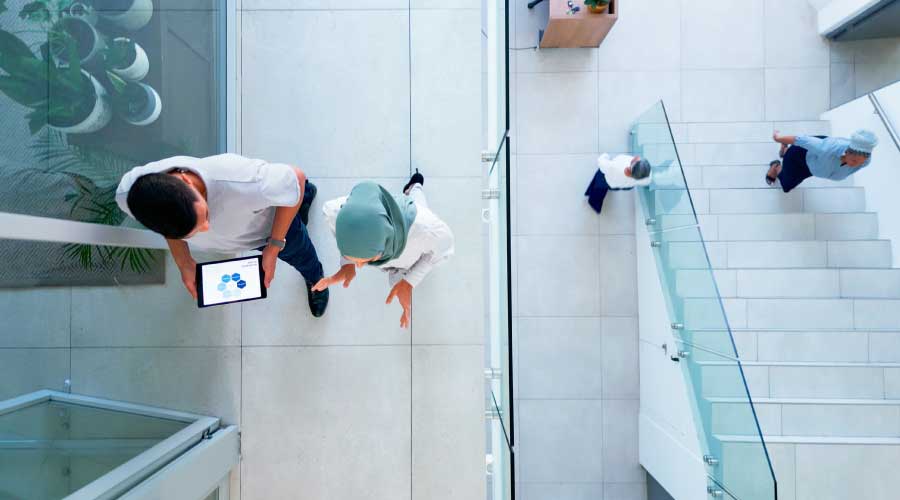New Ways of Working
Here's a piece of good news: The days of the cubicle farm appear to be drawing to a close, and a new generation of furniture is taking its place. "Most organizations today don't want cubicles," says Andrew Laing, a director with strategic business consultancy DEGW North America. "They want a variety of work settings."
Several shifts in the ways in which organizations work are driving the move away from cubicles. For starters, employees' ability to collaborate has become key to many organizations' success.
In addition, the work environment in many organizations no longer is top-down, with an employee's title dictating the size of his or her office, says Cheryl Brown, principal and senior interior designer with SmithGroup. "The hierarchical management style is obsolete. Creating places that people can thrive in and create is the word of the day," Brown says.
This shift has its roots in the bursting of the dot-com bubble, says Lisa Bottom, principal and workplace designer with Gensler. To be sure, the bursting led to difficult times for many organizations. On the positive side, it also prompted the companies that survived to approach work differently, Bottom says. To remain competitive, businesses in all sectors now needed "a faster track to market," she says.
Developing products and services as quickly as possible often requires that employees collaborate with people on different teams as needed. This contrasts with the conventional wisdom of a decade or two ago, which skewed to focused concentration, Bottom says. It was, "go to your office, close the door and think big thoughts."
Today, few employees sit at their desks for eight hours each day, says Tom Polucci, senior principal and director of interiors with HOK. While they may spend some time answering emails or working individually on a project, the rest of the time they are up and about, working with colleagues and going to clients, he says.
What's more, the increasingly mobile nature of technology means that many employees no longer are tethered to their workstations.
Furniture design and arrangements are facilitating these shifts. "You don't see repetitive desks and cubicles into infinity," says Joseph Coppola, principal with DattnerArchitects. Instead, the individual workspace is becoming a smaller proportion of the total workspace.
Another result is that the number of cubicle panels that reach 96 inches, effectively acting like walls, is dwindling. Many new panels today stop at about 42 inches, says Buzz Riley, senior project manager with IA Interior Architects.
The lower panels offer what's sometimes referred to as "seated privacy," Polucci says. That is, workers who are sitting down can't easily see or be distracted by their colleagues. However, once they stand up, they can view and connect with others. The lower panel heights also allow daylight to reach more employees, including those located well into the interior of an office.
It's not just the panel heights that are changing; furniture arrangements are as well. Employees' desks or workstations often are grouped so that four or six people on a team face each other. Some arrangements include a table and seating in the middle of the individual workstations, to which employees can pull up their chairs, Riley says. "People can sit down, read through notes or have a meeting," he says.
More Meeting Areas
As individual workspaces have shrunk, meeting areas have become more prevalent. In some offices, these can take the form of a "pantry" or break area, Riley says. Another option is groupings of soft seating areas throughout an office. In either case, these allow for chance encounters, enabling employees from different areas to cross paths and exchange ideas. Many areas also incorporate technology, such as tables with plug-ins for computers, which allow employees to work away from their desks.
While these areas are fairly open, many offices also include a mix of enclosed meeting rooms that provide a quiet space for several people to meet, along with conference rooms that allow for larger gatherings. Again, most make greater use of technology. For instance, the use of videoconferencing technology is growing, reducing employees' need to travel, Coppola says.
The move to a more collaborative environment is leading some companies to implement a design approach called "benching." As the term implies, a number of employees sit at a single, long work surface, or bench. The bench may incorporate dividers that delineate each employee's space, and offer a modicum of privacy. Some designs incorporate small filing cabinets that roll under the bench, offering storage and also acting as dividers between employees. While the bench itself is fixed, the other furniture tends to be mobile, Polucci says.
The benching concept is more common in Europe, where it's been in use longer. But it's gaining momentum in U.S. metropolitan areas where real estate is expensive, Polucci says.
In offices where many employees are present only a portion of the time, employees increasingly may be expected to practice "hoteling," and reserve the use of a workstation and furniture just for the times they are in the office. When that's the case, it's important that the furniture be able to adjust to accommodate different sizes of employees. "User-changeability is huge," Bottom says.
Similarly, the furniture that's designed to work just with a specific piece of technology also is becoming a thing of the past, Bottom says. "It has to be able to handle the next new thing."
Furniture systems also are lighter and more mobile than the heavier, paneled systems that were predominant a decade or two ago, Coppola says. That makes it easier for employees to move their workspace as needed.
The Office Neighborhood
Given the different ways workers use today's office, many designers are approaching the work environment as a series of neighborhoods. Most will include areas in which different teams are located, spaces for informal and formal meetings, along with offices or areas in which an employee can work individually. "By creating diverse spaces, people can always find a space that suits their needs," says Cherly Brown, principal and senior interior designer with SmithGroup.
Until recently, office spaces have tended toward muted tints and white. That seems to be shifting a bit with growing use of color. "It certainly enlivens the workspace," says Joseph Coppola, principal with DattnerArchitects. In addition, color can be used to delineate different areas within an office. In some workplaces, swatches of color are used against a neutral or white background.
The goal is to create "visual variety using textures, tones, values. You want some contrast," says Tom Polucci, senior principal and director of interiors with HOK. In many cases, the color comes from items that can be easily changed, such as a cushion that sits on top of a pedestal filing cabinet that's also used for seating. Color also may come from the architecture, rather than the furniture.
— Karen Kroll
|
Related Topics:












